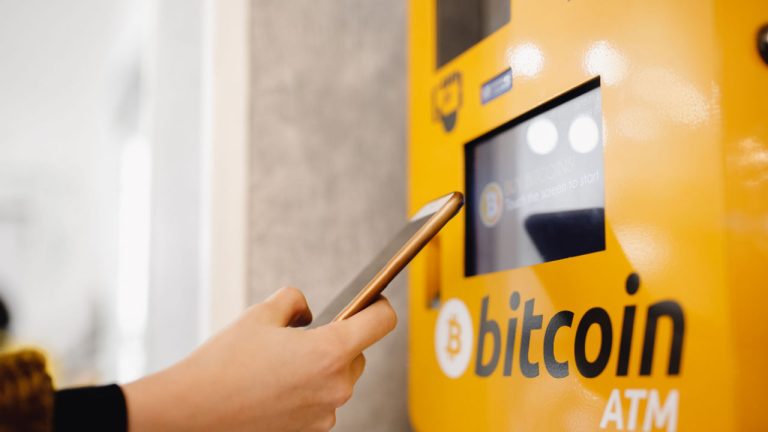 The number of ATMs supporting digital currencies has fallen around the world over the course of a turbulent year for the whole industry. According to a new report, the United States has lost more machines offering crypto teller services than any other country, while Australia tops the chart in terms of new installations. 2022 Ends […]
The number of ATMs supporting digital currencies has fallen around the world over the course of a turbulent year for the whole industry. According to a new report, the United States has lost more machines offering crypto teller services than any other country, while Australia tops the chart in terms of new installations. 2022 Ends […] At the end of November, an unknown person signed a signature tied to an extremely old block reward mined on Jan. 19, 2009, and the user published a message and verified signature linked to the reward on the forum bitcointalk.org. The message was tied to a bitcoin address associated with block 1,018, a block reward […]
At the end of November, an unknown person signed a signature tied to an extremely old block reward mined on Jan. 19, 2009, and the user published a message and verified signature linked to the reward on the forum bitcointalk.org. The message was tied to a bitcoin address associated with block 1,018, a block reward […]
The JPMorgan report is based on a study of cash transfers from banks to crypto accounts for over 5 million customers.
Around 13% of the American population — or 43 million people — have held cryptocurrency at some point in their lives, new research from JPMorgan Chase has revealed.
According to a Dec. 13 report titled: "The Dynamics and Demographics of U.S. Household Crypto-Asset Use,” this number has risen dramatically since before 2020 when the figure was only around 3%.
The latest data from JPMorgan comes from analyzing checking account transfers from a sample of over 5 million customers. It found that 600,000 customers in this sample group transferred cash to crypto accounts at some point during the 2020-2022 time period.
The study also noted that cryptocurrency holders typically made their first crypto purchases during spikes in crypto prices. During this time, the amount of cash being sent into crypto exchange accounts typically far outweigh the cash being removed. In other words, most people were holding onto their crypto during this time period.
This changed in early 2022 as crypto prices fell according to JPMorgan. In recent months, cash transfers into crypto exchanges have only slightly exceeded cash transfers out of them.
JPMorgan says that this is a result of both price declines in crypto and a broader trend of the savings rate declining in the United States since the pandemic:
“We view the rise and fall of crypto use since the onset of COVID as consistent with the joint relationship between retail flows and market prices seen in prior research. Additionally, the trend in crypto flows also tracks dynamics of household savings, which spiked to historic highs early in the pandemic but has begun to reverse.”
The report also weighed in on whether certain demographic groups are more likely to buy crypto. It found that men of all ages buy significantly more crypto than women, and younger people buy significantly more than older people. For example, the report found that over 25% of millennial men have bought crypto, whereas only around 12% of millennial women and 5% of male baby boomers have.

The research also found that crypto holdings were relatively minor for most individuals, with median flows equal to less than one week’s worth of “take-home pay.”
On the other hand, about 15% of crypto owners had more than a month’s pay invested in crypto.
Related: Arthur Hayes says Bitcoin has bottomed as “everyone who could go bankrupt has gone bankrupt”
The crypto market has gone through a dramatic fall in 2022. Bitcoin (BTC) has fallen from a 2022 high of $47,459 in March to $17,208 at the time of writing, while Ether (ETH) has fallen from $3,521 in April to $1,273 at the time of writing.
This fall in the crypto market has been the result of market shocks such as TerraUSD (UST) stablecoin losing its peg in May and crypto exchange FTX going bankrupt in November.
Trading fees have fallen on many crypto exchanges, and Coinbase has even stated that its revenue has fallen by nearly 50%.
But despite this decline in crypto prices and trading activity, this new report indicates that crypto ownership has still increased over the course of the last few years.
 Residents of the United States, South Korea and the Russian Federation have been the most frequent users of centralized exchanges this year, according to a new study. The finding comes after the spectacular crash of FTX, one of the largest such platforms, amid tightening regulations and fewer new users. U.S. Leads by Number of CEX […]
Residents of the United States, South Korea and the Russian Federation have been the most frequent users of centralized exchanges this year, according to a new study. The finding comes after the spectacular crash of FTX, one of the largest such platforms, amid tightening regulations and fewer new users. U.S. Leads by Number of CEX […]
The Bank for International Settlements (BIS) studied the main motives behind Bitcoin adoption by retail investors.
Bitcoin (BTC) investors are more likely enticed by the cryptocurrency’s rising prices, rather than their dislike of banks or its perceived use as a store of value, a new report from the Bank for International Settlements (BIS) suggests.
In a “BIS Working Papers” report published on Nov. 14, the central bank body looked into the relationship between Bitcoin prices, crypto trading, and retail adoption.
It studied the drivers of crypto adoption by retail investors using crypto trading app downloads as a proxy for adoption and user investments at the time of download.
It found that “a rise in the price of Bitcoin is associated with a significant increase in new users, ie entry of new investors” and that most retail investors “downloaded crypto apps when prices were high.”
The BIS presented evidence that daily downloads of crypto exchange apps increased with the rapidly rising price of Bitcoin between Jul. and Nov. 2021, peaking when Bitcoin’s price was between $55,000 and $60,000 roughly one month before its Nov. 2021 all-time high of just over $69,000.
It added 40% of crypto app users were men under 35 and were part of the most “risk-seeking” segment of the population, from this, it surmised:
“Users [are] being drawn to Bitcoin by rising prices — rather than a dislike for traditional banks, the search for a store of value or distrust in public institutions.”
“The price of Bitcoin remains the most important factor when we control for global uncertainty or volatility, contradicting explanations based on Bitcoin as a safe haven,” it added.
The BIS assumed app users purchased Bitcoin at the time of downloading a crypto app and subsequently supposed that up to “81% of users would have lost money” if they had purchased Bitcoin over $20,000.

The BIS’s assumptions seemingly correlate with data from blockchain analysis firm Glassnode, who on Nov. 14 confirmed that just over half of Bitcoin addresses are in profit, reaching a two-year low.
#Bitcoin $BTC Percent Addresses in Profit (7d MA) just reached a 2-year low of 51.881%
— glassnode alerts (@glassnodealerts) November 14, 2022
View metric:https://t.co/ik5IkrdoPk pic.twitter.com/boVDTqG8YL
The BIS added its analysis of blockchain data found as Bitcoin prices rose, smaller users purchased, and “the largest holders (the so-called ‘whales’ or ‘humpbacks’) were selling – making a return at the smaller users’ expense.”
Related: Turbulence for blockchain industry despite strong Bitcoin fundamentals: Report
It also documented the geography of crypto app adoption and found between Aug. 2015 to Jun. 2022 that Turkey, Singapore, the United States, and the United Kingdom had the highest total downloads per 100,000 people respectively.
India and China had the lowest, the latter seeing only 1,000 crypto app downloads per 100,000 people with the BIS opining that greater legal restrictions on crypto hamper retail adoption in those countries.
 Russians have been losing interest in Telegram channels devoted to cryptocurrencies and tokens, according to a new research covering the period since the start of the war in Ukraine. Industry experts behind the study say that bitcoin’s lower valuation and financial restrictions increasingly limiting access to the crypto market are the key reasons. Telegram Crypto […]
Russians have been losing interest in Telegram channels devoted to cryptocurrencies and tokens, according to a new research covering the period since the start of the war in Ukraine. Industry experts behind the study say that bitcoin’s lower valuation and financial restrictions increasingly limiting access to the crypto market are the key reasons. Telegram Crypto […] According to Dappradar’s latest crypto industry report that covers 2022’s third quarter, the crypto economy and its participants are “riding out the bear market.” However, these days a number of macroeconomic events have influenced the crypto market, and Dappradar researchers say it’s currently “impossible to foresee a worldwide expansion of cryptocurrencies without a general recovery […]
According to Dappradar’s latest crypto industry report that covers 2022’s third quarter, the crypto economy and its participants are “riding out the bear market.” However, these days a number of macroeconomic events have influenced the crypto market, and Dappradar researchers say it’s currently “impossible to foresee a worldwide expansion of cryptocurrencies without a general recovery […] Workers and executives in Latam are open to trying metaverse tools in conjunction with their traditional work, according to a study commissioned by Ciena, a software, networks, and services company. The study, which surveyed 15,000 business workers from all around the world, found that there is optimism about the implementation of these technologies. Latam Office […]
Workers and executives in Latam are open to trying metaverse tools in conjunction with their traditional work, according to a study commissioned by Ciena, a software, networks, and services company. The study, which surveyed 15,000 business workers from all around the world, found that there is optimism about the implementation of these technologies. Latam Office […] On September 2, the crypto market aggregation web portal Coingecko.com published a study that identifies the top ten states in America that are most interested in the two leading digital currencies, bitcoin and ethereum. The team leveraged Coingecko’s page traffic data and found that California captures 43% of the traffic visiting the site’s bitcoin and […]
On September 2, the crypto market aggregation web portal Coingecko.com published a study that identifies the top ten states in America that are most interested in the two leading digital currencies, bitcoin and ethereum. The team leveraged Coingecko’s page traffic data and found that California captures 43% of the traffic visiting the site’s bitcoin and […] The number of known cryptocurrencies surged from 6,000 in July 2021 to 10,400 in February 2022 before dropping to around 10,000 by August. Only five cryptocurrencies currently account for over 75% of the entire crypto industry market capitalization. A Thousand Cryptocurrencies Added Every Month According to the data from Augusta Free Press, the number of […]
The number of known cryptocurrencies surged from 6,000 in July 2021 to 10,400 in February 2022 before dropping to around 10,000 by August. Only five cryptocurrencies currently account for over 75% of the entire crypto industry market capitalization. A Thousand Cryptocurrencies Added Every Month According to the data from Augusta Free Press, the number of […]